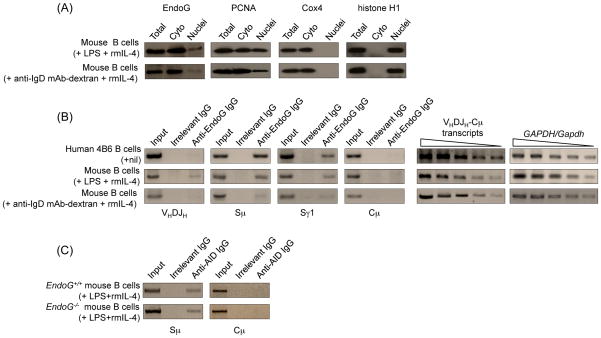Fig. 1.
EndoG is located in both the cytoplasm and the nucleus, and is specifically recruited to S regions in human and mouse B cells that undergo CSR. (A) EndoG, PCNA, Cox4 and histone H1 proteins in whole cell extracts, cytoplasm and nuclei of wild-type C57BL/6 mouse spleen B cells stimulated with LPS and rmIL-4, or anti-IgD mAb-dextran and rmIL-4 for 2 days, as detected by immunoblotting. (B) EndoG is recruited to S region but not CH region DNA. Left and middle panels: cross-linked chromatin was precipitated from human spontaneously switching 4B6 or C57BL/6 mouse spleen B cells stimulated with LPS and rmIL-4, or anti-IgD mAb-dextran and rmIL-4 for 2 days using a rabbit IgG Ab specific for EndoG or preimmune control rabbit IgG. The precipitated DNA was specified by PCR using human or mouse VHDJH, Sμ, Sγ1 or Cμ primers; right panels: VHDJH-Cμ and GAPDH/Gapdh transcripts in 4B6, LPS and rmIL-4- or anti-IgD mAb-dextran and rmIL-4-stimulated mouse spleen B cells were amplified by RT-PCR using two-fold diluted template cDNA. (C) EndoG-deficiency does not alter the recruitment of AID to S regions. Cross-linked chromatin was precipitated from EndoG+/+ and EndoG−/− B cells stimulated with LPS and rmIL-4 for 2 days using a IgG1 mAb specific for AID or a control mouse IgG1. The precipitated DNA was specified by PCR using mouse Sμ or Cμ primers.

